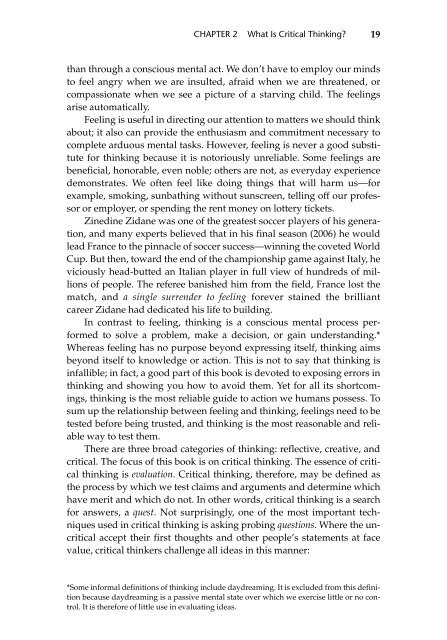Beyond Feelings
Beyond Feelings
Beyond Feelings
Create successful ePaper yourself
Turn your PDF publications into a flip-book with our unique Google optimized e-Paper software.
CHAPTER 2 What Is Critical Thinking?<br />
than through a conscious mental act. We don’t have to employ our minds<br />
to feel angry when we are insulted, afraid when we are threatened, or<br />
compassionate when we see a picture of a starving child. The feelings<br />
arise automatically.<br />
Feeling is useful in directing our attention to matters we should think<br />
about; it also can provide the enthusiasm and commitment necessary to<br />
complete arduous mental tasks. However, feeling is never a good substitute<br />
for thinking because it is notoriously unreliable. Some feelings are<br />
beneficial, honorable, even noble; others are not, as everyday experience<br />
demonstrates. We often feel like doing things that will harm us—for<br />
example, smoking, sunbathing without sunscreen, telling off our professor<br />
or employer, or spending the rent money on lottery tickets.<br />
Zinedine Zidane was one of the greatest soccer players of his generation,<br />
and many experts believed that in his final season (2006) he would<br />
lead France to the pinnacle of soccer success—winning the coveted World<br />
Cup. But then, toward the end of the championship game against Italy, he<br />
viciously head-butted an Italian player in full view of hundreds of millions<br />
of people. The referee banished him from the field, France lost the<br />
match, and a single surrender to feeling forever stained the brilliant<br />
career Zidane had dedicated his life to building.<br />
In contrast to feeling, thinking is a conscious mental process performed<br />
to solve a problem, make a decision, or gain understanding.*<br />
Whereas feeling has no purpose beyond expressing itself, thinking aims<br />
beyond itself to knowledge or action. This is not to say that thinking is<br />
infallible; in fact, a good part of this book is devoted to exposing errors in<br />
thinking and showing you how to avoid them. Yet for all its shortcomings,<br />
thinking is the most reliable guide to action we humans possess. To<br />
sum up the relationship between feeling and thinking, feelings need to be<br />
tested before being trusted, and thinking is the most reasonable and reliable<br />
way to test them.<br />
There are three broad categories of thinking: reflective, creative, and<br />
critical. The focus of this book is on critical thinking. The essence of critical<br />
thinking is evaluation. Critical thinking, therefore, may be defined as<br />
the process by which we test claims and arguments and determine which<br />
have merit and which do not. In other words, critical thinking is a search<br />
for answers, a quest. Not surprisingly, one of the most important techniques<br />
used in critical thinking is asking probing questions. Where the uncritical<br />
accept their first thoughts and other people’s statements at face<br />
value, critical thinkers challenge all ideas in this manner:<br />
*Some informal definitions of thinking include daydreaming. It is excluded from this definition<br />
because daydreaming is a passive mental state over which we exercise little or no control.<br />
It is therefore of little use in evaluating ideas.<br />
19


